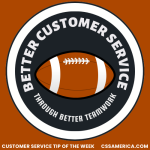 I’ve been reading a book recently about a Charlotte-based service company, and the author of the book conveys the CEO’s perspective on management, culture, and serving customers. At the back of the book, the author noted the organization’s Core Values. They are honesty, integrity, fairness, and respect. I literally did a double-take on the pages, because my company’s Core Values are respect, honesty, fairness, and integrity. Yes, the order is different, but the values are the exact same!
I’ve been reading a book recently about a Charlotte-based service company, and the author of the book conveys the CEO’s perspective on management, culture, and serving customers. At the back of the book, the author noted the organization’s Core Values. They are honesty, integrity, fairness, and respect. I literally did a double-take on the pages, because my company’s Core Values are respect, honesty, fairness, and integrity. Yes, the order is different, but the values are the exact same!
Maybe it’s a crazy coincidence, or maybe it’s that these are just really good values for any organization to have that truly wants to care about its team members and its customers.
Among those values, the one I want to discuss is integrity. Integrity is an important word, but it’s not always the most easily understood word. There was even a commercial a few years back where elementary school children were talking about the importance of integrity and defining it in their own words.
The way the CEO whose book I’m reading defined it was: Doing the right thing in all circumstances. It includes doing what we say we will do.
The way my company defines it is: Uncompromising adherence to moral and ethical principles.
Those definitions are not the exact same, but they don’t necessarily conflict either. The point is that we will be ethical. We will do what we say we will do. And we’re consistent about it.
My company uses the word “uncompromising.” The CEO of the service company uses the phrase “in all circumstances.”
The reason why this is important is not just because it is the right thing to do and the right way to treat other people, but it implies consistency. And where there is consistency in taking action that you stated you would take, where there is consistency in doing what is fundamentally right – the ethical thing – then you build trust.
In the long-term, you don’t want to work with somebody you cannot trust. Employees will not follow a leader they cannot trust. Customers will not stay with companies which they cannot trust.
To build lasting relationships, ensure that integrity is one of your Core Values.
Signup for FREE Tips! Contact Us More Resources for You Visit Our Home Page














 As a management consultant, oftentimes my job is to identify the key issues, determine the root causes, and provide solutions. We do a lot of strategy work, we conduct many research projects, and we train and train and train our clients. However, improvement usually involves pointing out what needs to be done differently, better, or more or less frequently in order to achieve the best outcomes possible.
As a management consultant, oftentimes my job is to identify the key issues, determine the root causes, and provide solutions. We do a lot of strategy work, we conduct many research projects, and we train and train and train our clients. However, improvement usually involves pointing out what needs to be done differently, better, or more or less frequently in order to achieve the best outcomes possible. The week of October 7 is National Customer Service Week. No, this wasn’t another holiday invented by Hallmark, so you have to go to work. Hopefully that’s the good news!
The week of October 7 is National Customer Service Week. No, this wasn’t another holiday invented by Hallmark, so you have to go to work. Hopefully that’s the good news!






